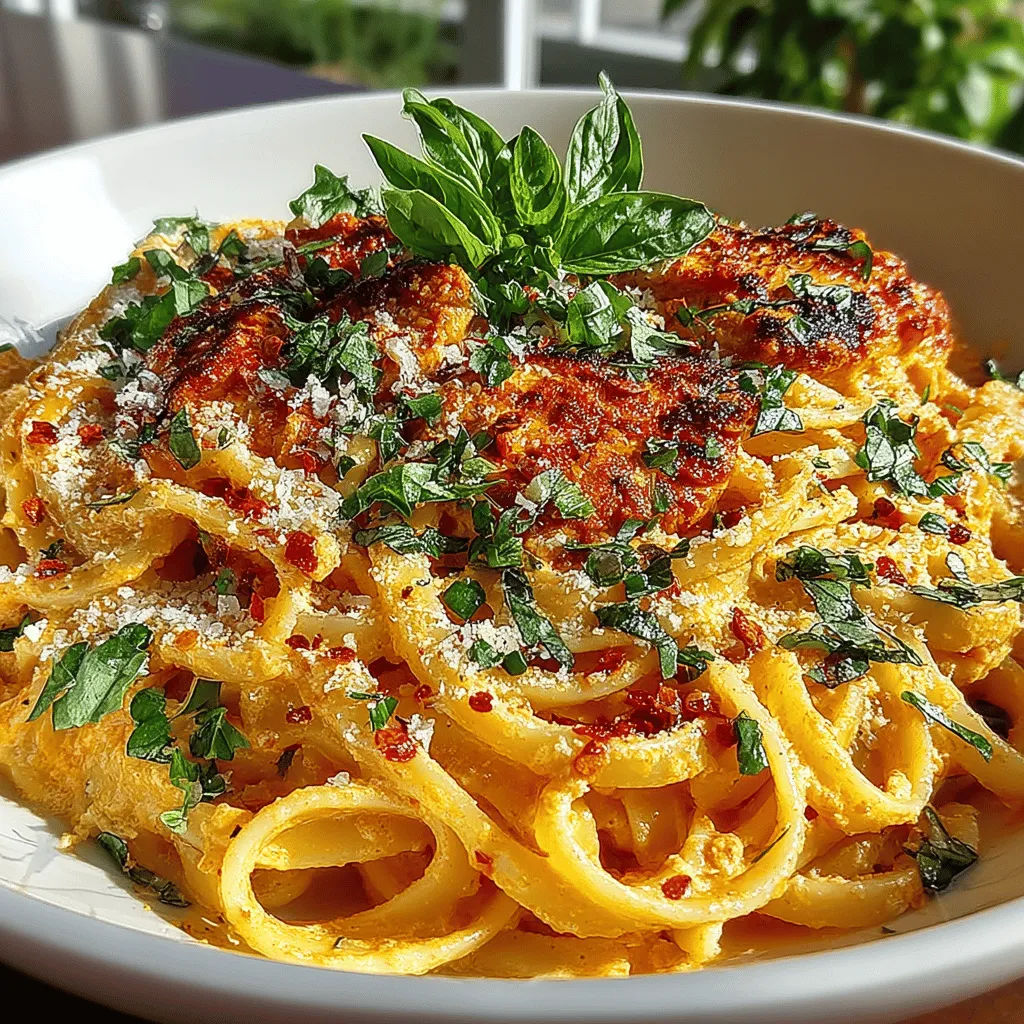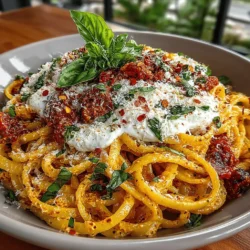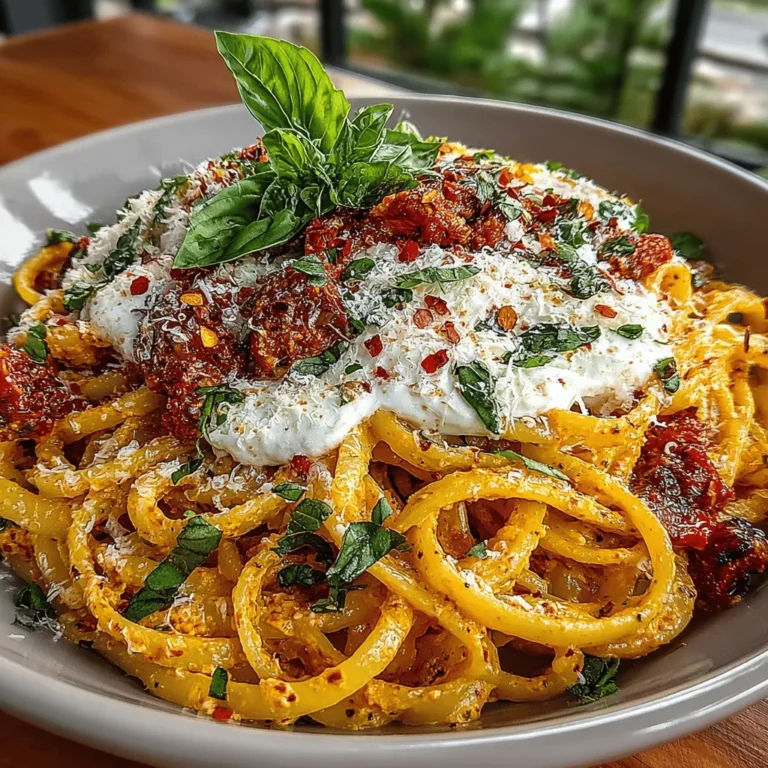Introduction
Creamy Tomato Basil Pasta is a delightful and satisfying dish that can be prepared in just 30 minutes. This recipe offers a perfect blend of flavors, combining the rich taste of tomatoes, the creaminess of heavy cream, and the fresh aroma of basil to create a comforting meal for any occasion. Whether you’re a busy professional or a home cook looking for a quick yet delicious dinner option, this pasta dish is sure to impress.
Ingredients
– 12 oz pasta (fettuccine, penne, or linguine)
– 2 tablespoons olive oil
– 3 cloves garlic, minced
– 1 can (14 oz) crushed tomatoes
– 1 teaspoon dried oregano
– 1 cup heavy cream
– Salt and pepper to taste
– 1 cup fresh basil leaves, chopped
– 1/2 cup grated Parmesan cheese
Instructions
1. Cook the Pasta: Begin by bringing a large pot of salted water to a boil. Add the pasta and cook according to package directions until al dente. Reserve 1/2 cup of pasta water, then drain the rest.
2. Sauté the Garlic: In a large skillet, heat the olive oil over medium heat. Add the minced garlic and sauté for about 1 minute, or until fragrant. Be cautious not to let it burn.
3. Create the Tomato Sauce: Pour in the crushed tomatoes and add the dried oregano. Stir well and let the mixture simmer for about 5 minutes, allowing the flavors to meld together.
4. Add the Cream: Lower the heat and stir in the heavy cream. Mix until fully combined, and season with salt and pepper to taste. Allow the sauce to simmer for an additional 3-4 minutes.
5. Combine Pasta and Sauce: Add the drained pasta to the sauce. Toss to coat the pasta evenly, adding a bit of reserved pasta water if the sauce is too thick.
6. Finish with Basil and Parmesan: Stir in the chopped fresh basil and grated Parmesan cheese until well incorporated. Serve hot and enjoy!
Understanding the Ingredients
Essential Pasta Choices
Choosing the right type of pasta can significantly affect the texture and flavor of your dish. Fettuccine, with its wide, flat shape, holds onto the creamy sauce beautifully, while penne’s tubular form captures the sauce inside, creating bursts of flavor with each bite. Linguine, being slightly thinner, provides a delicate balance to the rich sauce. Experimenting with these options can personalize your Creamy Tomato Basil Pasta experience.
The Role of Aromatics
Aromatics such as garlic play a crucial role in enhancing the dish’s flavor profile. When sautéed, garlic releases essential oils that contribute to the overall taste, creating a fragrant base that complements the tomatoes and cream. The key is to sauté garlic just until it becomes fragrant, avoiding overcooking, which can lead to bitterness.
Crushed Tomatoes: The Base of the Sauce
Crushed tomatoes serve as the foundational element of this sauce, offering a rich flavor and a slight acidity that balances well with the creaminess of the heavy cream. Their natural sweetness enhances the overall taste of the dish, while the acidity cuts through the richness, making each bite refreshing.
Creaminess of Heavy Cream
Heavy cream is essential for creating a luscious, velvety texture in the sauce. It not only adds a luxurious mouthfeel but also helps to balance the acidity of the tomatoes, resulting in a harmonious flavor profile that is both comforting and indulgent.
Fresh Basil: A Flavorful Finish
Fresh basil is a key ingredient that adds brightness and aroma to the dish. Its herbal notes transform the pasta into a fresh culinary experience, making it a must-have for this recipe. Adding the basil at the end preserves its vibrant flavor and color, ensuring that each bite is aromatic and flavorful.
Parmesan Cheese: The Perfect Finish
Parmesan cheese enhances the overall creaminess of the dish while adding a savory depth that rounds out the flavors. Its salty notes complement the sweetness of the tomatoes and the richness of the cream, making it the perfect finishing touch for your Creamy Tomato Basil Pasta.
Step-by-Step Cooking Instructions
Cooking the Pasta
To achieve the perfect al dente texture, bring a large pot of water to a rolling boil and add a generous amount of salt. The water should taste like the sea. Add the pasta and cook according to the package instructions, usually around 8-10 minutes. The goal is to have the pasta firm to the bite, so check for doneness a minute or two before the indicated time. Reserve 1/2 cup of the pasta cooking water before draining to adjust the sauce’s consistency if needed.
Sautéing Garlic to Perfection
To get the most flavor from garlic, heat olive oil in a skillet over medium heat until shimmering. Add the minced garlic and sauté for about 1 minute, stirring frequently to prevent burning. When the garlic turns a light golden color and becomes fragrant, it is ready for the next step. This technique ensures that the garlic imparts its full flavor into the dish without any bitterness.
Creating the Tomato Sauce
In the same skillet, add the crushed tomatoes and dried oregano after removing the sautéed garlic. Stir well to combine and let the mixture simmer for about 5 minutes. This simmering process allows the flavors to meld, creating a rich and cohesive sauce that will envelop the pasta beautifully. The simmering also helps to reduce the acidity of the tomatoes, resulting in a sweeter, well-rounded sauce.

Incorporating Heavy Cream
When adding heavy cream to your pasta sauce, it’s crucial to do so gradually. Start with a small amount to gauge the sauce’s thickness and creaminess before incorporating the rest. To avoid curdling, ensure that your sauce is at a low simmer rather than a rolling boil when you add the cream. This temperature control helps maintain a smooth texture and prevents the cream from separating, resulting in a luscious sauce that clings beautifully to your pasta.
Combining Pasta with Sauce
To effectively combine your cooked pasta with the creamy tomato sauce, first, reserve about a cup of pasta water before draining the noodles. This starchy water can be a game-changer in achieving the desired consistency. Add the drained pasta directly to the sauce, tossing to coat evenly. If the sauce seems too thick, gradually add the reserved pasta water a few tablespoons at a time until you reach the perfect creamy texture. This technique not only enhances the sauce but also ensures that every bite is flavorful.
Finishing Touches with Basil and Cheese
Once your pasta is well combined with the sauce, it’s time for the finishing touches. Tear fresh basil leaves and sprinkle them directly into the dish, allowing their aromatic oils to infuse the sauce. Next, add freshly grated Parmesan cheese, stirring gently to incorporate. This step adds depth and richness, creating a harmonious blend of flavors. For an extra touch, consider garnishing with additional cheese and basil just before serving to elevate the overall presentation.
Serving Suggestions
Plating the Dish
When plating your creamy tomato basil pasta, consider using a large, shallow bowl to allow the vibrant colors of the dish to shine. Twirl the pasta into a nest shape in the center of the bowl, then drizzle a bit of the sauce around the pasta for an artistic flair. A sprinkle of freshly ground black pepper can add an appealing contrast to the dish.
Garnishing for Visual Appeal
Garnishing plays a vital role in enhancing both flavor and aesthetics. Top your plated pasta with a few whole basil leaves and a generous sprinkle of grated Parmesan or Pecorino cheese. For an added touch of elegance, consider drizzling a little high-quality olive oil over the dish just before serving, which not only enhances flavor but also adds a glossy finish.
Nutritional Information
Breakdown of Key Nutrients
Understanding the nutritional content of your creamy tomato basil pasta is essential for making informed dietary choices. A typical serving of this dish contains approximately 400-500 calories, depending on portion size and added ingredients. It’s rich in carbohydrates, primarily from the pasta, and provides a good source of protein from the cheese. The heavy cream contributes fats, which can vary based on the type used. Fresh tomatoes and basil add vital vitamins and minerals, making this dish a balanced option when enjoyed in moderation.
Variations and Customizations
Vegetarian and Vegan Options
For those following a vegetarian or vegan diet, there are several ways to adapt this recipe. Substitute the heavy cream with coconut milk or cashew cream for a creamy texture without dairy. Nutritional yeast can replace Parmesan cheese, providing a cheesy flavor while keeping the dish plant-based.
Adding Proteins
To make this pasta dish more filling, consider adding protein options like grilled chicken or sautéed shrimp. For a vegetarian protein boost, chickpeas or lentils can be mixed in, adding both texture and nutrition to the meal.
Exploring Additional Vegetables
Incorporating seasonal vegetables not only enhances the dish’s flavor but also increases its nutritional value. Spinach or kale can be stirred in just before serving, wilting them slightly in the warm sauce. Bell peppers, zucchini, or cherry tomatoes can also be sautéed with the garlic for added color and taste.
Conclusion
In conclusion, the 30-Minute Creamy Tomato Basil Pasta Delight is an accessible and flavorful dish that brings together the richness of cream and tomatoes with the freshness of basil. Perfect for weeknight dinners or special occasions, this recipe is a testament to the beauty of simple ingredients coming together to create something truly delightful. With its ease of preparation and versatility, this pasta dish is sure to become a favorite in your culinary repertoire.


